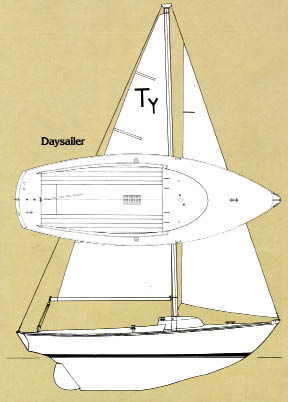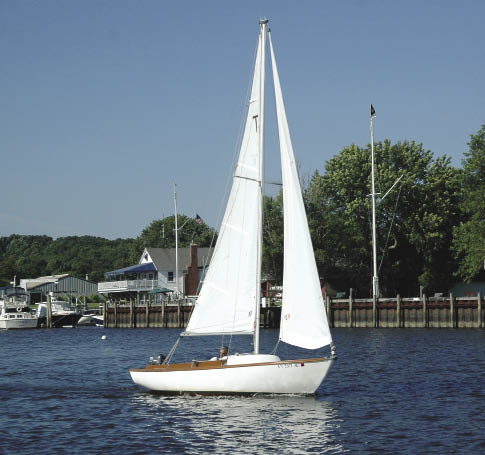Cape Dory Typhoon
A tough and forgiving Alberg-designed classic
 For this month's small boat issue we're taking a close look at a pint-sized classic, the Cape Dory Typhoon. Designed by the late Carl Alberg, the 18-foot, 6-inch Typhoon has been called, "America's littlest yacht."
For this month's small boat issue we're taking a close look at a pint-sized classic, the Cape Dory Typhoon. Designed by the late Carl Alberg, the 18-foot, 6-inch Typhoon has been called, "America's littlest yacht."
It is certainly one of America's best-loved small boats, more than 2,000 were built during a 20-year production run that ended in 1986. Typhoons are coveted on the used boat market and there's no telling where you might find one. I've seen Typhoons searching for breeze on small inland lakes, riding the brisk trades of the Caribbean and, most frequently, easing along the gentle curves of a New England bay. It's a boat that beginners and seasoned sailors alike appreciate because it satisfies on many levels. It's aesthetically pleasing, responds to a sure hand on the helm, is safe in a blow and steady when an annoying powerboat stirs up a chop. It's not a sport boat-heck, it's not fast by any definition-but it's still a delight to sail. I can see the day when I am done crossing oceans, I'll own a sweet little Typhoon and spend my afternoons gliding about the harbor, checking out all the new boats. The Typhoon is a boat to sail just for sake of sailing, one of those things you understand intrinsically or you never will.
Dubbed the "stubborn Swede" by author Dan Spurr, Carl Alberg was a prolific designer who rarely receives the credit he deserves for ushering in the fiberglass age. From the Pearson Ariel and Triton, to the Bristol 27, to the entire Cape Dory range, to the Alberg 30, 35 and 37, his conservative designs bridged the transition from wood to glass and always included long keels, moderate freeboard, slack bilges and plenty of displacement.
"In my designs I go for a boat that you can sail upright without scaring the life out of your family or friends," Alberg wrote. Plenty of sailors have appreciated his simple philosophy, he designed 56 boats in all and more than 10,000 have been launched to date.
Cape Dory, founded by Andrew Vavolotis in 1963 in East Taunton, Massachusetts, introduced the Typhoon four years later. The boat was an immediate hit. And why not? It is a lovely vessel with salty lines, bronze fittings and a regal bearing in the water. I remember, it must have been 1973 or '74, spying a Typhoon swinging on a mooring on Higgins Lake in Northern Michigan. It stirred me. I was just a kid but was already reading books like Dove, Sailing Alone Around the World, and Eric Hiscock's Voyaging Under Sail. To my parents dismay, I was dreaming of dropping out of school and sailing over the horizon. Every day that summer I tacked my Sunfish around the Typhoon, picturing myself aboard it, out in the Pacific, en route to a remote atoll.
First impressions
The Typhoon has handsome lines. The sweeping sheer accentuates a perky bow with a fine entry and trails into a soft reverse transom revealing serious overhangs. The LOA is 18 feet, 6 inches and the LWL is just 13 feet, 11 inches. Go ahead, calculate the hull speed based on the LWL. I told you the Typhoon was not a sport boat, but it's a better performer than the numbers suggest.
There were three different Typhoon models, the Weekender, the Daysailer with a cuddy cabin, and an open daysailer. Late in the production Cape Dory added a 22-foot, 6-inch Typhoon Senior but not many were built. Most Typhoons, in fact about 90 percent, were Weekenders. These can be identified by the small coachroof with a single bronze port on each side and by their 3/4-fractional rig. Weekenders also included a compact interior that allowed flexible folks the option of camping out for a few days.
The daysailers were masthead sloops. All models have a classic Alberg long keel hull shape with a cutaway forefoot and attached rudder. The Typhoon has some weight to it, displacing 2,000 pounds including 900 pounds of ballast. The air draft of the Weekender is 28 feet and slightly less on the daysailers.
Construction
The Typhoon is a conservative design and Cape Dory followed suit with conservative-minded construction, which became a hallmark of all its later boats. The Typhoon hull is solid, hand-laid fiberglass with scantlings exceeding those found on most 25-footers. The deck is balsa cored and joined on an inward-facing flange. The fiberglass work was very well done, especially the tabbings. The hull is supported with real floors, impressive for a small boat, and the internal ballast eliminates the need for keelbolts, always a good thing on an older boat. Teak coaming boards line the cockpit and a teak toerail is another item to maintain.
What to look for
If you are considering a Daysailer model you should know that they don't have self-bailing cockpits. Weekenders do, however. There are plenty of items to look for in any older fiberglass boat, especially when some are 40 years old. Some specific Typhoon problems include deck crazing and cracking, especially in the cockpit and around the chainplates. Mast depression on the coachroof is solved by adding a beefed-up compression post. Portlight windows usually need to be replaced every few years. Of course, consider changing out the standing and running rigging. Also, one owner notes that the coaming boards should be replaced every 20 years. This assumes that you are going to own your Typhoon for a very long time. The Cape Dory Sailboat Owner's Association, CDSOA, www.capedory.org, is a good resource. A quaint newsletter, The Typhooner, was published by Noel Peattie until his death in 2005. The California Cape Dory Owners group has all 18 of these newsletters available online.
On deck
The cockpit is the heart of the Typhoon, and it's terrific. The seats are more than six feet long, and although the coamings can be a bit hard on your back, there's enough room to shift around and find a comfortable position. There are also two good-sized cockpit lockers. In fact, the Typhoon has impressive storage throughout. The tiller is well positioned at the aft end of the foot well. It doesn't take up a lot of space, you can brace yourself when heeled, and it can be tied out of the way when anchored or at the dock. The mainsheet is typically led aft to two fixed blocks on the stern deck just behind the wheel. The sheeting angle is not ideal but at least it is out of the way. I have seen Typhoons with a retrofitted traveler mounted across the cockpit seats but this clutters up the cockpit and isn't really necessary.
The mast featured internal halyards that were led aft, one to each side of the aft deckhouse. This was innovative in its day. The halyards are led to cleats on the vertical backs of the deckhouse; jammers on top are nicer. The small sheet winches are usually not necessary unless flying a genoa or spinnaker. The headsail tracks are mounted on the coachroof for the jib and there's a fixed-point lead on the side deck for larger headsails. The standard boom was fitted with a small worm gear that allowed it to rotate. Do you remember roller reefing? It was a great idea that never worked very well. The concept was that the main could be reefed around the rotating boom. The problem was that it was difficult to achieve a neat wrap, especially if it was blowing, which it usually is when you need to reef. Switching to slab reefing is
a good idea.
Down below
There isn't much down below on the Weekender, less on the Daysailer with its cuddy cabin, and nothing on the open daysailer. So let's take a quick look at the Weekender. The companionway is actually wide and easy to negotiate, just be prepared to stoop when you arrive in the cabin. There are quarterberths to either side and a V-berth forward. Once you manage to get into them, the berths are comfortable enough. There's space for a portable ice chest and small stove. Most boats have a porta potty in the cutout of the V-berth, some even came with a real marine head. Either option seems unnecessary, that's what buckets and marina bathrooms were made for. There is plenty of storage space under the berths. Lets put it this way, if it's raining the interior of a Typhoon Weekender is a lot better than a tent ashore.
Engine
Although most Typhoons have outboard brackets mounted on the stern, and a handful came with inboard diesels, the question is: Why spoil the fun with an engine at all? I know, some marinas are impossible to negotiate without an engine, and if it is dead calm it's nice to fire up the outboard and steam home. A few years ago I watched a Typhoon pick up a mooring in Menemsha Harbor on Martha's Vineyard by using a long sweep mounted astern. The solo skipper calmly turned his wrist back and forth, pushing the Typhoon along decently and then reached over and plucked the pennant. If you insist on a outboard, many owners report that a six-horsepower is about the right size.
Underway I have sailed a Typhoon twice, once in the Virgin Islands years ago, and in Biscayne Bay just a few summers back. We had a delightful day in the bay with winds steady around 15 knots. This is a perfect location for a Typhoon and its 2-foot, 7-inch draft. We skipped over 4-foot and 5-foot shoals without a care. The Typhoon is stiff and seems to have a sweet spot about 50 degrees off. You can feel the rudder hum when you have everything trimmed right. There's a bit of weather helm, as much a function of the long-keel hull shape and smallish rudder as anything else, but it makes steering easier because you have a pressure point for the tiller.
I have sailed a Typhoon twice, once in the Virgin Islands years ago, and in Biscayne Bay just a few summers back. We had a delightful day in the bay with winds steady around 15 knots. This is a perfect location for a Typhoon and its 2-foot, 7-inch draft. We skipped over 4-foot and 5-foot shoals without a care. The Typhoon is stiff and seems to have a sweet spot about 50 degrees off. You can feel the rudder hum when you have everything trimmed right. There's a bit of weather helm, as much a function of the long-keel hull shape and smallish rudder as anything else, but it makes steering easier because you have a pressure point for the tiller.
The bay was choppy and I was impressed by the Typhoon's ability to maintain momentum, like a larger boat, and avoid getting stopped dead by an obnoxious passing wake. Owners report that the Typhoon powers up nicely under genoa. Off the wind, the long boom tends to ride up, and a vang really helps. Bringing the boat through the wind you're reminded that you have a full keel under you. Still, the Typhoon gathers way fairly quickly and the ride is always steady.
Conclusion
The Cape Dory Typhoon is an enduring classic. It's handsome, nimble, affordable and downright pleasant under sail. Give me a few more years and then keep your eyes out, you'll see me puttering about the harbor one day. I'll be the guy without an engine but with a big smile.

Comments